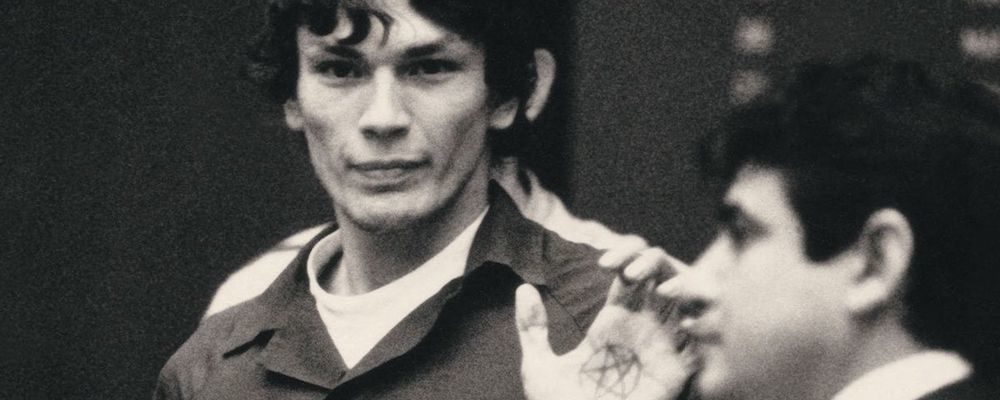‘Night Stalker: A Serial Killer’s Murderous Rampage Is Captured With Nightmarish Intensity
Alci Rengifo
Netflix docuseries “Night Stalker: The Hunt for a Serial Killer” boasts a deceptive title that would make you think this is some kind of pulse-pounding thriller. Instead it has the force of a living nightmare. The name in its title is instantly familiar to followers of true crime. In the summer of 1985 Los Angeles was gripped by the escalating and horrific crimes of serial killer Richard Ramirez, known by the name given to him during the press frenzy, the Night Stalker. With famous murder cases and infamous maniacs now providing fodder for countless docuseries in every streaming service, there’s a temptation to dismiss this as another exploitative tour through grisly history. But that’s not the case. What “Night Stalker” does so well is journey into the very human suffering of its subject matter.
Those seeking a lurid profile of Ramirez, who remains a chilling sight with that cold stare and taunting grin, should know the name isn’t even uttered for the first two of the docuseries’ four episodes. The real focus is on LA detectives Gil Carrillo and Frank Salerno, who became top names in the team that worked desperately hard to find out who was killing, raping and kidnapping victims ranging from children to the elderly in that terrible year. Their own back stories are in themselves insightful microcosms of Los Angeles life. Carrillo hails from the city’s Latino east side, where he proved himself by going to the military, living through the Vietnam War and then returning home to join law enforcement. Once he entered the detective world, he had to avoid the racist stereotypes whites would impose even more in the ‘70s on their Latino neighbors. But nothing could prove a greater forging of minds than the need to solve the Night Stalker’s brutal trail of death.
What begins as a hard-boiled detective profile in the tradition of LA procedurals then morphs into a chronicle fueled by an unnerving tension. Director Tiller Russell brings a powerful sense of atmosphere to the way he tells this story. The streets of the city are filmed like shadowy, menacing corners similar to how David Fincher evoked a gothic San Francisco in “Zodiac.” This combines with vintage news footage of the time and flourishes of ‘80s music for a slice of dark nostalgia. What Russell does differently from other typical exercises in giving everything a VHS look or throwing in references to Madonna, is strip down the sensationalism in exchange for unforgettable, personal testimonials. While Carillo and Salerno look back at the frustration of hunting for clues, survivors of Ramirez’s rampage sit in front of the camera and somehow have the courage to describe an ordeal no one ever deserves to endure. A small girl who was kidnapped and molested by Ramirez is now grown, testifying for us 36 years later with crushing, vivid memories. A woman who found her parents bludgeoned to death in their bedroom can’t help but have her voice still shake when reliving the moment.
“Night Stalker” does not generate suspense so much as the very sense of dread that can engulf a community. Russell never shies away from the crime scene photos, the bloodied close-ups of a body or the most wrenching details of a survivors’ testimony. In a sense this docuseries shames all those shows that romanticize killers or exert themselves trying to piece together over-the-top plot schemes. Like Netflix’s great drama series “Mindhunter,” this is TV channeling a different dark side, the one that soberly admits this can be a terrifying world sometimes, with shattered minds and predators. The LA of 1985 comes across as under siege. Carrillo recalls barely getting any sleep, his buzzer constantly going off with news of an attack. Eventually one case seemed to edge closer to his neighborhood. What made the Night Stalker case particularly unnerving was how Ramirez did not target a specific group or demographic. His crimes seemed random yet calculated, with a classic M.O. being that he would take advantage of windows or doors that could be easily opened. For a long time the central clue would be Ramirez’s footprints, all bearing the mark of the same shoe brand. Other aspects of the case and manhunt are riveting in their frustrations and simplicities, like a moment where Carrillo and Salerno come close to nabbing Ramirez at a dentist’s office.
Eventually the series must culminate in the famous capture of Ramirez, who was part of that bizarre and unsettling wave of killers who became media fixtures. Like Ted Bundy, Ramirez assumed a bizarre form of perverse pop culture status. Originally from El Paso, Texas and raised among abusers and a deranged Vietnam veteran, Ramirez comes across as a perturbed psyche that fell into a combination of narcissism and murder. But in court he cut a striking Satanic figure with his long hair, pentagram tattoos and “hail Satan” yells. This generated groupies as well. Russell includes photographs women would send Ramirez, many in provocative, even nude, poses. It all seems so pathetic and grotesque when juxtaposed with the chilling crimes we are guided through in the previous three episodes.
“Night Stalker” is riveting as true crime but haunting as well for its human angle. Sometimes one has to put aside all the fascination with police work while watching and contemplating on the people who unfortunately were in Ramirez’s destructive path. Behind sensational crime headlines are lives forever scarred. Carrillo and Salerno can’t help but look haunted when reminiscing about certain moments in the case. To stare into the abyss can have profound and lasting aftershocks. Many of us will hopefully never have the experience of seeing murder and madness in person, but the subjects of this docuseries did. They make this series something not only visceral and absorbing, but brave.
“Night Stalker: The Hunt for a Serial Killer” begins streaming Jan. 13 on Netflix.

